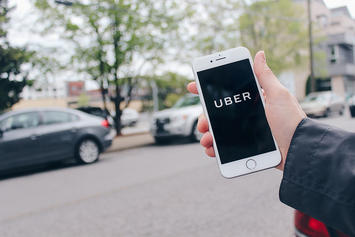
Over the past few weeks, ridesharing in the United States has rolled in an important new direction: Uber has expanded “Uber Express Pool” to twelve urbanized areas: Atlanta, Boston, Chicago, Denver, Los Angeles, Miami, Philadelphia, San Diego, San Francisco, Washington D.C., Seattle and northern New Jersey. The new service, like Uber Pool, provides customers with a lower fare in exchange for accepting other pick-ups and drop offs along the way. Rather than providing door-to-door service, however, users to walk a short distance, perhaps a couple of blocks, at the beginning and end of their journey.
The payoff is a significantly lower fare. Having designated pickup and drop-off points allows for less circuitous rides while increasing the chances of the driver being able to handle several travel parties at each stop. It is akin to a high-tech jitney—and will certainly keep public transit operators on their toes.
We have studied its implications for mobility and taken numerous trips on Uber Express Pool here in Chicago, where it launched just three week ago. Five findings stand out:
1. Uber Express Pool has a “countdown clock” that generally runs up to two minutes before a pick up location is provided to the rider. Riders are given a map of the possible pickup zone before committing to their trip. After committing, a timer appears at the top of the screen, which often runs for a minute or two minutes, before an exact pickup location is provided. Having this countdown period allows the company to evaluate supply and demand conditions--and see if other riders materialize--before developing the route.

Uber app showing the new Express Pool option and a rectangular pickup zone.
Walks of about two minutes are customary, although several extra minutes are added as a buffer after your arrival at the pickup point, which can be a little aggravating if you are a fast walker. Interestingly, the app, once you are onboard, provides notification when others passengers will be joining the ride, complete with his/her screen name and pick-up location, which is not the case on Uber Pool. Your drop-off point often changes as your trip progresses.
2. Uber Express Pool is priced well below Uber Pool and UberX even on routes in which other pickups and drop-offs seem unlikely. On trips in the 4 – 10 mile range, this new service is generally priced 55 – 65% below UberX, making it substantially less costly than Uber Pool, which is generally priced about 35 – 45% less. A six-mile trip from downtown Chicago to Wrigley Field typically costs around $5.40, compared to $8.00 on UberPool and $15.00 for Uber X—and making it only about $3 more expensive that riding an “L” train.

An Uber graphic showing the benefits of having users walk several blocks to reduce travel times.
Using Uber Express Pool on longer-distance trips seem less compelling since savings do not rise proportionately with the length of the trip, instead remaining about $2 to $5 range compared to Uber Pool, although we found savings as high as $8 in highly congested parts of San Francisco.
3. Rider should expect total trip times to be about the same as Uber Pool, making the chief disadvantage being exertion and stress of walking to and from pickup/drop off spots. Nevertheless, Express trips seem more predictable than Uber Pool trips due to the optimization of pick up/drop off locations.
4. Uber Express Pool differs sharply from Lyft Shuttle, which operates to and from pre-determined stops over a pre-determined routes. Both draw from the same pool of drivers as their other services and generally transport you in automobiles rather than vans or mini-buses, as is the case on Via, the “microtransit” operator now in three U.S. cities. Lyft Shuttle, however, is generally available only on selected corridors during high demand periods, and is presently limited to Chicago and San Francisco, whereas Uber Express Pool is more universal. Its website provides a map of all the available pick-up and drop-off locations, and fares are substantially less than its Uber counterpart, often being just $3 or $3.50.

Lyft Shuttle routes showing designated stops near downtown Chicago. The service operates from 6:30-10:30 a.m. and 4-8 p.m.
5. Uber Express Pool will appeal to travelers who might otherwise take public transit more than its other services. Using UberX or UberPool instead of public transit tends to be quite costly when measured in terms of the amount spent per unit of time saved. Our newly released study shows that, on 4 - 10 mile trips between neighborhoods in Chicago, UberX and Uber Pool users are spending the equivalent of about $40 and $80 per hour saved, respectively. The value proposition differs sharply between routes but, generally, these services are too expensive for most commuters who travel more than a few miles to use every day.
Uber Express Pool, however, is different. Users often spend only about $30 per hour saved. Although its cost tends to be higher than the $15/hr. “value of time” rate often assumed for the typical transit passenger, travelers who put a premium on their time will no doubt find it hard to resist. Moreover, when transit service is slow or erratic, Uber Express Pool is often a bargain, and the greatest benefit to many will be the added comfort of traveling in a quiet and climate controlled vehicle rather than a bus or train.
Uber rolled big discounts for this new service even on routes in which the demand for ridesharing demand is thin, indicating that the company is willing to incur short-term revenue losses to build awareness of this new product.
It will be fascinating to watch how these microtransit options change the way people move from place to place--they appear poised to be game changers.
Joseph Schwieterman, Ph.D., is professor of Public Services and director of the Chaddick Institute for Metropolitan Development at DePaul University in Chicago. His co-authored study Uber Economics was released in May.
Top photo credit: quotecatalog.com, via Flickr, using CC License.












